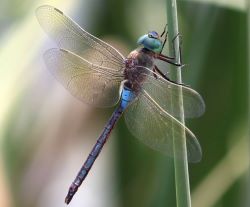 Mumbai / Pune, India: In a groundbreaking study, researchers at MIT-WPU, Pune, revealed the population dynamics of dragonfly species in Pune based on historical and contemporary data. Researchers found that eight species previously recorded in historical data are now absent, suggesting possible local extinctions due to unplanned urbanization, increased water pollution, and shifting weather patterns. The study also records addition of twenty-seven species compared to historical data, a significant number achieved due to citizen science and increased awareness regarding documentation of insect diversity. The study identifies shifts in dragonfly populations caused by factors such as changing land use, rapid urbanization, and data gaps.
Mumbai / Pune, India: In a groundbreaking study, researchers at MIT-WPU, Pune, revealed the population dynamics of dragonfly species in Pune based on historical and contemporary data. Researchers found that eight species previously recorded in historical data are now absent, suggesting possible local extinctions due to unplanned urbanization, increased water pollution, and shifting weather patterns. The study also records addition of twenty-seven species compared to historical data, a significant number achieved due to citizen science and increased awareness regarding documentation of insect diversity. The study identifies shifts in dragonfly populations caused by factors such as changing land use, rapid urbanization, and data gaps.
The study also recorded the presence of five endemic species from the Western Ghats, reinforcing Pune’s ecological significance for Odonata studies. This first-of-its-kind study examines the long-term temporal distribution of odonates (dragonflies and damselflies) in the Pune district, shedding light on species losses and gains over nearly two centuries.
The research, led by Dr. Pankaj Koparde (Faculty, Department of Environmental Studies, MIT-WPU Pune), along with Arajush Payra (PhD Scholar) and Ameya Deshpande (Alumnus), presents a comprehensive analysis of historical and contemporary records. Primary data was collected between 2019 and 2022 across 52 localities in the Pune district, while historical records from the mid-19th century were reviewed through 25 published articles and citizen science data.
Researchers from MIT World Peace University (MIT-WPU) have published this groundbreaking study, titled “Odonata Diversity in the Timescape of Pune District Adjoining the Western Ghats Biodiversity Hotspot,” in the International Journal of Tropical Insect Science (Springer Nature Publishing).
“Dragonflies are crucial insect predators that help regulate mosquito and pest populations in urban areas. Their role is comparable to that of tigers in a forest ecosystem. Monitoring their populations is essential for assessing environmental health,” said Dr. Pankaj Koparde, lead researcher of the study.
Compared to historical records, researchers today have access to advanced data collection techniques, citizen science initiatives, and increased awareness, allowing for a more refined understanding of biodiversity trends. The study also identifies Warje and Vetal Hills, along with Pashan Lake, as the most species-rich locations within the Pune Municipal Corporation (PMC) limits.
Building on these findings, MIT-WPU researchers are currently studying the impact of urbanization and water pollution on dragonflies along the Mula River. They are also establishing long-term monitoring projects to track diversity changes over time.
“We need to prioritize the conservation of urban green and blue spaces such as hills, grasslands, rivers, and lakes. Sustainable development planning is crucial to preserving natural ecosystems amid rapid urban expansion,” stated Arajush Payra, co-researcher on the study.
This study is part of a larger research initiative on dragonfly diversity across the Western Ghats, funded by the Department of Science & Technology (DST), Government of India. The researchers hope their findings will inspire more studies on biodiversity shifts across various taxa and encourage the establishment of long-term monitoring projects to aid conservation efforts.
 Newspatrolling.com News cum Content Syndication Portal Online
Newspatrolling.com News cum Content Syndication Portal Online







